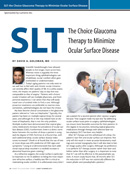Choice Glaucoma Therapy to Minimize Ocular Surface Disease
By DAVID A. GOLDMAN, MD
 Scientific breakthroughs have allowed people to live longer, more active lives. Whereas vision is arguably the most important thing ophthalmologists can rehabilitate, ocular comfort often goes overlooked or underestimated. Today’s aging patients not only want to see well but to feel well, and chronic ocular irritation can severely affect their quality of life. In a utility assessment, the impact on patients’ day-to-day lives was comparable to that of angina.1 Patients with chronic ocular irritation will see multiple physicians, and from personal experience, I can attest that they will easily travel over a hundred miles to find a cure. Although proactive treatments are preferable to reactive ones, sometimes, ophthalmologists do not have the choice.
Scientific breakthroughs have allowed people to live longer, more active lives. Whereas vision is arguably the most important thing ophthalmologists can rehabilitate, ocular comfort often goes overlooked or underestimated. Today’s aging patients not only want to see well but to feel well, and chronic ocular irritation can severely affect their quality of life. In a utility assessment, the impact on patients’ day-to-day lives was comparable to that of angina.1 Patients with chronic ocular irritation will see multiple physicians, and from personal experience, I can attest that they will easily travel over a hundred miles to find a cure. Although proactive treatments are preferable to reactive ones, sometimes, ophthalmologists do not have the choice.
My least favorite clinical consultation is the glaucoma patient referred to “rule out blepharitis.” Typically, this patient has been on multiple topical drops for several years, and although he or she may indeed have an element of blepharitis, that is not the only problem. Multiple studies have demonstrated that topical glaucoma medications increase the prevalence of ocular surace disease (OSD). Furthermore, there is a direct correation between the number of drops a patient is using and the degree of OSD. Fechtner et al found that, with each additional drop, ocular surface disease index scores increased.2 Ghosh et al found that the use of two or more drops was 69% predictive of OSD signs and symptoms.3 Leung et al demonstrated that each additional topical drop resulted in a twofold increase in abnormal lissamine green staining.4
As a refractive surgeon, the ocular surface is particulary important to me. In addition to being the most important refractive surface, a healthy tear film is critical to maintaining ocular comfort. It is unfortunate every time I see a patient for a second opinion after cataract surgery because “that surgeon made my eyes dry.” By addressing ocular surface issues prior to surgery, ophthalmologists can ensure more favorable outcomes for their patients. In this regard, in my practice, removing topical glaucoma medications through therapy with selective laser trabeculoplasty (SLT) has been very helpful.
After SLT therapy and the withdrawal of a drop, the ptient’s tear film and ocular surface can improve. Not only will this result in more accurate keratometry readings and corneal topography, but it will also lead to better image quality after surgery. Although my preference is to perform SLT therapy sooner rather than later and before rather than after surgery, it is important to note that SLT can still be effective in the pseudophakic patient. A recent study found that, 30 months after SLT, the reduction in IOP was not statistically different between phakic and pseudophakic patients.5
In addition to improved ocular comfort, SLT patients are also very thankful for the money they save from requiring fewer or no monthly prescriptions for glauco- ma medications. Should their IOP rise over time, SLT can be repeated with successful outcomes.6,7
Ultimately, by using treatments such as SLT as primary therapy for glaucoma patients, we may decrease their overall risk of developing OSD. This will translate into a more comfortable lifestyle for the patient, more accurate corneal measurements for the physician, and more enjoyable surgical experiences for both the physician and the patient. For pseudophakes who are using drops and have significant OSD, ophthalmologists’ removal of even one medication by performing SLT can still greatly improve the ocular surface and result in happier patients.
David A. Goldman, MD, is an assistant professor of clini- cal ophthalmology at Bascom Palmer Eye Institute in Palm Beach Gardens, Florida. He is a consultant to Alcon Laboratories, Inc.; Allergan, Inc.; Bausch + Lomb; and Lumenis Inc. Dr. Goldman may be reached at (561) 515- 1543; dgoldman@med.miami.edu.
- Schiffman RM,Walt JG,Jacobsen G,et al.Utility assessment among patients with dry eye disease.Ophthalmology. 2003;110(7):1412-1419.
- Fechtner RD,Budenz DL,Godfrey DG,et al.Prevalence of ocular surface disease symptoms in glaucoma patients on IOP-lowering medications.Poster presented at:American Glaucoma Society 18th Annual Meeting;March 8,2008; Washington, DC.
- Ghosh S,Crowston J,Lamoureux E,et al.Assessment of prevalence of ocular toxicity in glaucomatous patients. Paper presented at: AAO Annual Meeting; November 10, 2008; Atlanta, GA.
- LeungEW,MedeirosFA,WeinrebRN.Prevalenceofocularsurfacediseaseinglaucomapatients.JGlaucoma. 2008;17(5):350-355.
- ShazlyTA,LatinaMA,DagianisJJ,ChitturiS.Effectofpriorcataractsurgeryonthelong-termoutcomeofselective laser trabeculoplasty.Clin Ophthalmol.2011;5:377-380.
- Francis BA,Katz J,Bacharach J,et al.Repeatability of selective laser trabeculoplasty.Paper presented at:American Glaucoma Society 21st Annual Meeting; March 3, 2011; Dana Point, CA.
- Jindra LF,Miglino E,Gupta A.Effectiveness of selective laser trabeculoplasty as primary,secondary,and repeat treatment in patients with glaucoma.Poster presented at:The ASCRS Symposium on Cataract,IOL and Refractive Surgery;April 27-May 2,2007:San Diego,CA
Share This